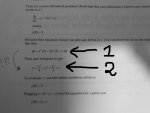Hello,
At 49 years of age I'm catching up on the math I didn't care to understand earlier on in life.
I'm reading "Differential Equations Workbook for Dummies" by Steven Holzner.
On page 10 (for those who have the book), I stuck on an elliptic explanation as to integrating an equation.
Time for a more advanced problem!
. . . . .\(\displaystyle \dfrac{dy}{dx}\, =\, x^3\, -\, 3x^2\, +\, x, \quad y(0)\, =\, 3\)
Because this equation doesn't involve any terms in y, you can move the dx to the right like this:
. . . . .\(\displaystyle \color{green}{\mbox{1. }\, dy\, =\, x^3\ dx\, -\, 3x^2\ dx\, +\, x\ dx}\)
Then just integrate to get
. . . . .\(\displaystyle \color{green}{\mbox{2. }\, y\, =\, \dfrac{x^4}{4}\, -\, x^3\, +\, \dfrac{x^2}{2}\, +\, c}\)
To evaluate c, use the initial condition, which is
. . . . .\(\displaystyle y(0)\, =\, 3\)
Plugging \(\displaystyle x\, =\, 0\) and \(\displaystyle y(0)\, =\, 3,\) into the equation for y gives you
. . . . .\(\displaystyle y(0)\, =\, 3\, =\, c\)
Could someone please explain how you get from 1 to 2?
Thank you!
At 49 years of age I'm catching up on the math I didn't care to understand earlier on in life.
I'm reading "Differential Equations Workbook for Dummies" by Steven Holzner.
On page 10 (for those who have the book), I stuck on an elliptic explanation as to integrating an equation.
Time for a more advanced problem!
. . . . .\(\displaystyle \dfrac{dy}{dx}\, =\, x^3\, -\, 3x^2\, +\, x, \quad y(0)\, =\, 3\)
Because this equation doesn't involve any terms in y, you can move the dx to the right like this:
. . . . .\(\displaystyle \color{green}{\mbox{1. }\, dy\, =\, x^3\ dx\, -\, 3x^2\ dx\, +\, x\ dx}\)
Then just integrate to get
. . . . .\(\displaystyle \color{green}{\mbox{2. }\, y\, =\, \dfrac{x^4}{4}\, -\, x^3\, +\, \dfrac{x^2}{2}\, +\, c}\)
To evaluate c, use the initial condition, which is
. . . . .\(\displaystyle y(0)\, =\, 3\)
Plugging \(\displaystyle x\, =\, 0\) and \(\displaystyle y(0)\, =\, 3,\) into the equation for y gives you
. . . . .\(\displaystyle y(0)\, =\, 3\, =\, c\)
Could someone please explain how you get from 1 to 2?
Thank you!
Attachments
Last edited by a moderator:



